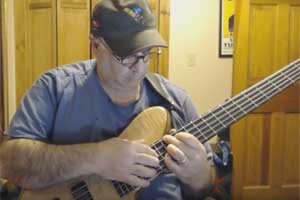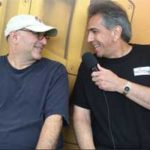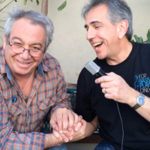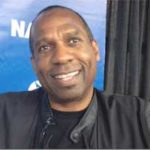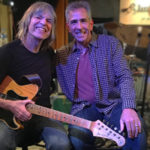Solo bass master explains the chordal approach, his Berklee experience and high-tech bass gear!
Exclusive interview with FBPO’s Jon Liebman
November 9, 2009
Mike Dimin is a bassist, author and educator. He has dedicated the last thirty years to expanding the role of the bass and educating a legion of bassists to the possibilities that lie within themselves and their instrument.
Through his groundbreaking books, The Chordal Approach and The Art of Solo Bass, and his work as a lesson columnist for Bass Guitar, Bassics, and Bass Frontiers magazines, Mike has brought the concept of solo bass, as well as arranging for solo and multiple basses, to the fore. As a product specialist for Zon Guitars, Euphonic Audio and Thomasik-Infeld strings, Mike has been given the opportunity to combine the two things he loves most: playing and teaching bass. Mike has released two CDs as a leader, Big Droppins and There Are No Accidents, both on his own label, Michael Dimin and the Big Droppins. He currently makes his home in upstate New York.
FBPO: You’re known as a bass player, writer, equipment tech, product endorser and educator. Help me focus in a little on who you are and what you do.
MD: I have always been an educator. It is from that background that all else stems. It was the investigation of chord-melody playing and solo bass that originally led me to write The Chordal Approach, my first book, which was self-published.
The Chordal Approach opened many doors for me. My desire to share what I had been delving into led to a stint as a lesson columnist and editor for Bass Frontiers magazine. Rewarding relationships with companies like Fodera, MTD and now Zon guitars, as well as Thomastik Infeld and Euphonic Audio, followed. The mutually beneficial role as endorsing artist led to workshops and clinics at prestigious places, including the Bass Collective. It was just one more way for me to share my vision.
As bass sites on the Internet began to really take hold, I was one of the original “Ask The Pros” at Talkbass and Bassically.net. At this time, EA asked me to write some PR and edit some manuals for them. Day by day, my role increased and now I am, as I jokingly like to say, the “Manager of Everything That Nobody Likes to Do.”
The follow-up book, The Art of Solo Bass: The Chordal Approach (Mel Bay), allowed me to give back one more time to those who have been so supportive of me throughout the years. Besides The Art of Solo Bass, I am continuing my work with EA and writing a lesson column for both Bass Guitar Magazine (UK) and the soon to be revamped Bassics Magazine.
My favorite thing is to present a clinic, workshop or master class. I love the interaction, the immediacy of the moment. You can see the light bulbs go off. It is such a rewarding experience.
FBPO: When recounting their stories, a lot of bass players have told me that at one time their interest in the bass was moderate at best, until that one magical day when they heard Jaco Pastorius and after that their lives were changed forever. I understand you had a similar experience.
MD: There were two years in my life that can be considered landmark years. The first was 1976. It was the year that both Return to Forever’s Romantic Warrior and Jaco’s eponymous debut album were released. Although I had been playing bass for about five years, I cannot remember a single day before that time. My serious approach to the bass began at that point. I vividly recall sitting in my teacher’s studio, listening to and analyzing Romantic Warrior.
The second landmark moment in my musical life came in 1987. I was living in the woods at the top of a mountain in Vermont when my mother called me to tell me that the “bassist [I] liked so much had died.” I remember sitting on the dirt floor in the basement of the local library, looking through weeks of obituaries in the New York Times before I finally found Jaco’s. It was at that moment that I new that it was no longer okay to just sit and play for my own enjoyment. I needed to share the solo work I had been doing since the late ’70s when I was at Berklee (College of Music). At that moment, The Chordal Approach was born and a fire was lit within me. I felt like I had found my true calling, which was to bring new perspectives to the bass community.
FBPO: Tell me about the time your experience at Berklee.
MD: Even though I was dead broke and had my motorcycle stolen the first month I was in Boston, Berklee was the most wonderful musical period of my life. I was there in the late ’70s and early ’80s. I had discovered Jaco a few years earlier and my ears and mind were open. I had always been a “theory guy,” so I had a strong working knowledge when I got there. For me, the formal education was not as important as the people I met, the jams we had and the free flow of musical ideas with both peers and faculty. I ate breakfast with Steve Vai, took lessons from Randy Coven, studied with John Neves, played in ensemble class with Donald Harrison and Branford Marsalis and got “schooled” in the blues by Melissa Etheridge!
FBPO: What inspired you to write The Art of Solo Bass: The Chordal Approach?
MD: The Art of Solo Bass: The Chordal Approach is a follow up the original The Chordal Approach. The original The Chordal Approach was self published and, as such, did not have actual arrangements in it. Mel Bay saw the potential in writing a follow up with actual arrangements as well as some newer ideas, like looping and employing extended range basses. Those ideas that were not around when I originally conceived The Chordal Approach.
FBPO: How would you describe your CDs, Big Droppins and There Are No Accidents?
MD: Big Droppins is a great record. It has music that had been evolving for twenty years before we recorded it. I had visions of certain songs that really came to fruition with that project. I wrote two of the pieces with Paul McCandless in mind and was able to get him to record the soprano sax parts. There are also some solo bass pieces that represent the first true recordings of those arrangements. More importantly, after a very long time of being relegated to playing solo, I was able to perform with an ensemble of people I like and respect. The music is very reminiscent of some of the older ECM recordings, very ethereal in nature. My daughter’s old preschool still uses it at rest time for the children.
There Are No Accidents was a blast to record! I got together some truly original musicians, like my old Berklee classmate Mark Dziuba on guitar, and Brian Melick on percussion. We went into the studio with no rehearsals and did everything in one take. What you hear is what you get. Oftentimes we never even got back to the head. The studio had a B3 and my pianist said, “Hey let’s try a B3 on this tune,” so we did. The interplay within the group is outstanding. Since I am known mostly for solo bass, it is a bit of a surprise to some that solo bass only plays a minor role on each of my recordings. The most important thing is the music.
FBPO: Talk a little bit about your technical side, the work you do with basses, gear, strings, etc.
MD: As a solo bassist, the search to find just the right gear is constant. Companies build gear to appeal to the largest market. The typical bass sound we all love so much is not ideal for solo bass. When playing chords, chord melodies or four or five simultaneous loops on the bass, a certain clarity and balance across the strings is vital, as is frequency range. For years I searched for an instrument that can be set up with tolerances to a thousandth of an inch and provide enough tonal variation for solo bass, from blues to funk and everything else. I looked for strings that are easy to play and don’t have too much overtone content. Finally, I needed an amp rig that was studio quality and could produce all the tones with a clarity and definition normally available only in a full-range amp and cab. Being in the industry and having a chance to meet many builders, manufacturers, sales reps and players has afforded me the ability to try many things and find the tools that work best for what I do.
The graphite neck of the Zon guitars has a stability that is just amazing. Whether I need to use alternative tunings or simply adjust to the normal weather changes here in the great northeast, I can count on the Zon to keep its relief of 4/1,000ths of an inch. The graphite neck also provides so much clarity! The only bass I have played that comes close to the clarity of the graphite neck was an MTD bass I once had with an ash neck.
For strings I use Thomastik-Infeld Jazz Rounds (E to C). TI strings are known more for their flats than their rounds and these strings are not for everyone. They are very soft to the touch with a superfine outer winding. They have a silk wrap between the inner core and outer wrap that provides a very strong fundamental and diminishes the overtones somewhat.
Finally, my relationship with EA rounds out the picture. I get to provide input on the things I like to see in an amp. The Intelligent Input Switching of the new Micro amps was one of my ideas. Having genius designers at your disposal and artists like Lee Sklar and Mike Arnopol, whose work and sound I admire so much, is such a huge help in determining my needs
FBPO: What was the Bassics gig like? How would you decide what to write about?
MD: After the demise of Bass Frontiers, Ron Garant, editor or Bassics, asked me to write a lesson column on solo bass for Bassics. There were three things that he wanted: a complete piece that people could play, something from the public domain and a video of the lesson for the enhanced CD that came with each issue. The search for and arranging of cool tunes written before 1924 was one of the great challenges. Songs like “Saint James Infirmary” or “Morning has Broken” that are in the public domain fit this bill.
Ron was also cool with me creating original pieces.
Much is the same for Bass Guitar magazine, although Nick Wells, the editor, prefers original pieces. Nick is a truly great editor. He really cares about each lesson and how his readers will interpret it. His suggestions are very helpful. My latest lesson for Bass Guitar is about how to harmonize a melody. My daughter has just started piano lessons and when I heard her practicing “Ode to Joy,” I chose that melody to harmonize. The first lesson was a pretty straightforward, diatonic arrangement. I am currently working on the next lesson, which will contain a little more interesting harmony.
FBPO: How much playing are you doing these days?
MD: I have not been working solo as much as I’d like. I have just been invited to perform two clinics in the spring, one in Detroit and the other in Chicago. I also have standing offers to perform clinics in Philly and Virginia, so I will be gearing up for them. For the first time in over a decade, I am playing in a band: Rhett Tyler & Early Warning. Rhett is a master guitar slinger who has been battling Lyme Disease. It really put a damper on his career for a while. But he is feeling better and put a band back together. Although these lousy economic times don’t bode well for a comeback, gigs are still coming in. There are times, however, when playing with the band, I remember just why I went solo.
FBPO: What else is occupying your time?
MD: I do a great deal of teaching. I teach music production and video production at a residential school for at-risk girls and volunteer, teaching DAW (digital audio workstation), at my son’s school. I am writing for two magazines and working with EA. Since sailing season is over and ski season has not started, this is a good time to enjoy the fall here in the northeast – the leaves are gorgeous! – spend time with the family and get back to practicing my solo stuff.
FBPO: What’s next for Mike Dimin?
MD: I am gearing up to write some more. I have a concept for a spy novel based very loosely on the experiences of two of my friends. One is a federal undercover agent and the other spent several years as a guitar tech for a major touring act. I have also talked with Lee Sklar about writing a book with transcriptions of his favorite bass lines, with commentary from him on what made each line so great and the story behind the recording. Lee is one of the most musical cats I have ever heard. Elegant in their simplicity, his lines are always perfect for whatever song he is playing.
FBPO: What else do you like to do that doesn’t necessarily involve music?
MD: I was a ski instructor for twenty years until I quit in 2000. Now my daughter is skiing and my son is snowboarding. It is how we spend our Sundays in the winter. Skiing with my daughter reminds me of the joy of my youth. We sail all summer. My son just started solo sailing this past summer and righting his capsized boat is our family’s traditional passage into manhood!
